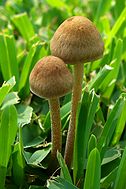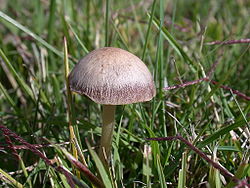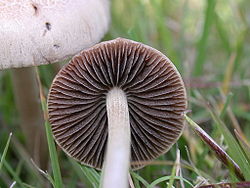
Panaeolina foenisecii
Encyclopedia
Panaeolina foenisecii, commonly called the mower's mushroom, haymaker or brown hay mushroom, is a very common and widely distributed little brown mushroom often found on lawns. It fruits in warm weather and contains the hallucinogen psilocybin
. In 1963 Tyler and Smith found that this mushroom contains serotonin
, 5-htp and 5-hydroxyindoleacetic acid
.
It is sometimes mistaken for the hallucinogenic Panaeolus subbalteatus
or Panaeolus castaneifolius
which both share the same habitat and can be differentiated by their jet black spores.




Psilocybin
Psilocybin is a naturally occurring psychedelic prodrug, with mind-altering effects similar to those of LSD and mescaline, after it is converted to psilocin. The effects can include altered thinking processes, perceptual distortions, an altered sense of time, and spiritual experiences, as well as...
. In 1963 Tyler and Smith found that this mushroom contains serotonin
Serotonin
Serotonin or 5-hydroxytryptamine is a monoamine neurotransmitter. Biochemically derived from tryptophan, serotonin is primarily found in the gastrointestinal tract, platelets, and in the central nervous system of animals including humans...
, 5-htp and 5-hydroxyindoleacetic acid
5-Hydroxyindoleacetic acid
5-Hydroxyindoleacetic acid is the main metabolite of serotonin in the human body. In chemical analysis of urine samples, 5-HIAA is used to determine the body's levels of serotonin.- Clinical significance :...
.
It is sometimes mistaken for the hallucinogenic Panaeolus subbalteatus
Panaeolus subbalteatus
Panaeolus cinctulus, commonly known as the banded mottlegill, is a very common, widely-distributed psilocybin mushroom. According to David Arora, Panaeolus cinctulus is the most common psilocybin mushroom in California....
or Panaeolus castaneifolius
Panaeolus castaneifolius
Panaeolus olivaceus is a semi-rare and widely distributed little brown mushroom which contains the hallucinogen psilocybin, is often mistaken for Panaeolina foenisecii, and is distinguished by its black spore print and darker gill coloration when mature, as well as a slightly thicker stem...
which both share the same habitat and can be differentiated by their jet black spores.
Description
- Cap: 1.5 to 3 cm across, conic to convex, chestnut brown to tan, hygrophanousHygrophanousThe adjective hygrophanous refers to the color change of mushroom tissue as it loses or absorbs water, which causes the pileipellis to become more transparent when wet and opaque when dry....
, often with a dark band around the margin which fades as the mushroom dries. - Gills: Broad, adnate, brown with lighter edges, becoming mottled as the spores mature.
- Spores: Walnut brown, 13 x 7 micrometers, finely roughened with an apical germ pore.
- Stipe: 4 to 6 cm by 2 to 3 mm, fragile, hollow, white to light brown, pruinose and slightly striate.
- Taste: A slightly unpleasant nutty fungal taste.
- Odor: Nutty, slightly unpleasant.





